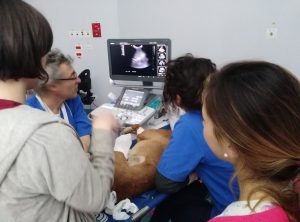Multidetector-row computed tomographic characteristics of presumed preureteral vena cava in cats
Pey P, Marcon O, Drigo M, Specchi S, Bertolini G.
Multidetector-row computed tomographic characteristics of presumed preureteral vena cava in cats
Vet Radiol Ultrasound. 2015 Jul-Aug;56(4):359-66. doi: 10.1111/vru.12251. Epub 2015 Mar 19
Abstract
Preureteral vena cava (circumcaval ureter, retrocaval ureter) occurs in a third of the feline population and has been associated with ureteral strictures in humans. The aim of this retrospective cross-sectional study was to describe the contrast-enhanced multidetector row computed tomographic (MDCT) characteristics of presumed preureteral vena cava in a group of cats. Medical records from two institutions located in different continents were searched from 2010-2013 for cases with complete contrast-enhanced MDCT examinations of the abdomen (i.e. included the entire course of the ureters and prerenal and renal segments of the caudal vena cava) and a diagnosis of preureteral caudal vena cava. For cases meeting inclusion criteria, CT scan data were retrieved and characteristics of the preureteral caudal vena cava were recorded. Presence of concomitant renal or ureteral diseases was also recorded. A total of 272 cats had contrast-enhanced abdominal CT scans during the study period and of these, 68 cats (22.43 ± 4.96%) had a diagnosis of presumed preureteral vena cava. In all affected cats, a “reverse-J ureter” was observed, i.e. a ureter running medially at the level of L4-5, passing dorsally to the caudal vena cava and then exiting ventrally between the caudal vena cava and aorta returning to its normal position. Having a preureteral vena cava resulted in an increased risk for concurrent urinary signs (OR = 3.00; CI: 95%; 1.28-6.99; P = 0.01). Findings supported the use of contrast-enhanced MDCT for characterizing morphology of preureteral vena cava and its relation with ureters in cats.






 Il Direttore Sanitario Dott. Marco Caldin
Il Direttore Sanitario Dott. Marco Caldin